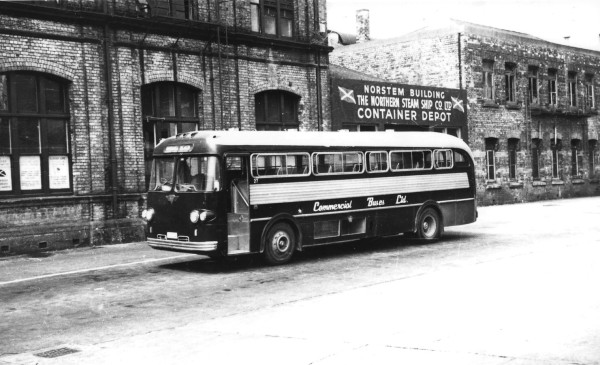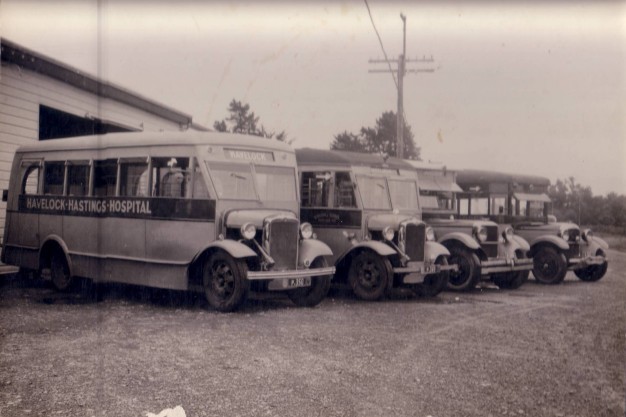Our History
The Bus and Coach industry has a long pioneering history in New Zealand.
Read about the evolution of the BCA and the different bus and coach sectors into what we see today.
The Bus and Coach Association (NZ) Inc. was first established in 1931 and has operated, under various names, continuously ever since.
The name of the Association reflects our origin.
- The "Bus" comes from the NZ Motor Omnibus Proprietors Association (est. 1931) who ran urban omnibus services.
- The "Coach" is an abbreviation for "service coach", the vehicle descended from the horse-drawn coach, and the service car, a long motor car.
New Zealand’s first bus ‘drivers’ had a number of new skills to learn as well in the transition from working with animals to working with machinery. Many a first time driver would yell ‘whoa!’ when putting on the vehicle's brakes, and not to mention the need to not only to be skilled drivers, but also expert mechanics.
Punctures and puncture repairs were standard on most trips and when drivers ran out of inner tubes, they were known to stuff the tyre casing with grass or flax to get home, brakes were primitive, lighting was minimal or non-existent and inventions like windscreen wipers were some time away.
You can find out more about our history over the years below.
The Early Days
New Zealand’s first ‘bus’ was used in Nelson in 1862 to travel the 1km stretch of road between the city and the port. It was a heavy wooden vehicle hauled by horses along a set of tracks.
At the beginning of the 20th century a number of cities and some towns had tram or bus networks but most were still horse drawn with attempts to modernise the industry haphazard, and largely unsuccessful. Many of the early buses were in fact large cars.
Early pioneers included Hot Lakes Transport Company (Rotorua) and and the Mount Cook Motor Company who began driving passengers between Auckland and Rotorua and the Hermitage respectively before also taking on postal services.
1900 marked the first significant technological development in the New Zealand bus and coach industry with the introduction of an electric tram in Dunedin, this was soon followed with the first extensive tramway in Auckland in 1902.
The first organisation in New Zealand of long distance route and tourist service operators was the AARD Motor Services Association of NZ, formed in 1918.
1920s
The 1920s marked a period of growth, and trial and error. Electric buses began to be used in a number of towns around New Zealand, while trams had become a standard urban public transport offering, but there was little control over entry into the industry.
Operators were required to hold a license but for person of good character this was merely a matter of handing over one pound to the local council. Until 1927 it wasn’t even necessary to hold a commercial driver’s license.
Following WW1, family based bus businesses began flourishing and road conditions began to improve. The introduction of the Education Department’s school transport policy in 1924 - a free bus service for school children more 3.2 kilometres away from their nearest school – also presented opportunity (as well as a more competitive mind-set) for fledgling companies.
The New Zealand Railways regarded these new ‘bus’ companies warily, but put up with them as long as they concentrated on routes not serviced by rail links. And eventually in the 1920s the Railway Service formed their own bus services.
The genesis of the BCA began in the 1920s when the government of the day enabled local authorities to restrict entry to the passenger transport industry through the Motor Omnibus Act of 1926. The rapid rise of privately owned bus companies was too much for local authorities who had invested huge sums into their own tramways and bus companies.
The bus industry realised it needed to work together to survive in a much more regulated environment.
The success of the Motor Services Association, mainly in the North Island, led to the establishment in the South Island of White Star Tourist Services in 1924.
1930s
The Motor Omnibus Act of 1926 and the Transport Licensing Act of 1931 both enacted huge regulations on the industry.
Transport Licensing Act of 1931 both enacted huge regulations on the industry.
All operators now faced the same regulation therefore it made sense to join forces to navigate the challenges together and what was to become the BCA was first registered on 9 June 1931 as the New Zealand Motor Omnibus Proprietors Association Inc (MOPA).
The first national conference of bus company owners was held in Wellington on 13 June, 1931. Norman Bell of the Bell Bus Company of Wellington was elected first president and at that first meeting operators made a number of important recommendations for the future of the industry:
By the 1930s the Motor Services Association was in decline, and by 1935 the South Island association, White Star Tourist Services, was renamed the NZ Passenger Services Federation.
• the government fix fares based on an average flat rate
• a permanent contractual relationship was made between NZ Railways Department and existing operators to prevent further harmful competition
1940s and 1950s
Tourism suffered during the war, but as tourism numbers  bounced back in the late 40s and 50s a number of companies began offering package tours to overseas visitors, which provided a lucrative work stream for coach companies. In the late 1940s the first Wellington to Auckland bus service was established, providing the first real competition for the then dominant rail service.
bounced back in the late 40s and 50s a number of companies began offering package tours to overseas visitors, which provided a lucrative work stream for coach companies. In the late 1940s the first Wellington to Auckland bus service was established, providing the first real competition for the then dominant rail service.
Meanwhile New Zealand’s main centres began removing trams, which were replaced by buses – heralding a temporary boon for bus companies. However, competition was fierce across the industry as operators looked to take advantage of loop holes in licensing rules to gain an advantage over their rivals.
By the late 1950s, despite population growth, tourism, and the removal of trams providing increased business, operating costs were becoming an increasing problem for both long-distance and urban operators – especially because fares were fixed. Faced with escalating costs, operators had no choice but to band together and seek approval to raise fares.
1960s and 1970s
MOPA amalgamated with the NZ Passenger Services Federation in 1965, and became the Road Passenger Services Association of NZ Inc (RPSA).
School operators continued to have their own organisation and formed the New Zealand School Transport Contractors Association (STCA) in 1960. While there was an initial tension between school operators and other passenger operators, STCA eventually became associate members of the RPSA in 1967.
The Road Passenger Services Association of NZ was renamed in 1972 as the Bus and Coach Association (NZ) Inc.
The licensing system which gave preference to local and central government operators was always a bone of contention, and a review of the licensing system was a major part of the BCA manifesto in the 1970s.
From the 1970s the BCA started moving closer to the School Transport Contractors Association, and they combined their conferences from 1977

.
In 1983 the Transport Amendment Act (No2) made it no longer necessary for applicants of transport licenses to show a need for the proposed services – opening up competition to let the market to decide a reasonable fare for the service. The new legislation resulted in a flurry of amalgamations and the number of current licenses dropped from 1853 in 1983 to 936 in 1985.
longer necessary for applicants of transport licenses to show a need for the proposed services – opening up competition to let the market to decide a reasonable fare for the service. The new legislation resulted in a flurry of amalgamations and the number of current licenses dropped from 1853 in 1983 to 936 in 1985.
A formal merger was proposed between the Bus and Coach Association and the School Transport Contractors Association in 1984 with a full amalgamation in 1989.
With the deregulation laws of the 1980s came a major change in the industry including:
- The State Owned Enterprise Act of 1986 corporatised many parts of central government that could be expected to trade as commercial entities, including NZ Rail, which had dominated the bus and coach industry.
- The Labour Relations Act 1987 abolished the 74-year-old system of compulsory arbitration and foreshadowed the 1990 Employment Contracts Act, which did away with compulsory unionism.
- “Tomorrow’s Schools” introduced bulk funding and direct resourcing, which resulted in some schools supplying their own vehicle and driver.
- The dismantling of import controls also led to an influx of overseas vehicles and a dwindling in the number of locally owned vehicle producers.

By the late- 80s a number of mergers had occurred with many operators big and small going out of business.
In 1989 the Transporting Services Licensing Act (TSLA) looked to address quality issues that had become apparent, opening up the entire transport industry for competition including urban services.
Some cities chose do away with their bus services, some chose new operators, while Christchurch, Dunedin, Wellington and Auckland decided to corporatise their city bus companies. The job of setting desirable levels of scheduled passenger service and allocating routes to subsidised commercial operators remains in the hands of Regional Councils.
The effect of deregulation was most obvious for our sector in school transport. At its introduction in 1987 a new tendering system resulted in a number of long time operators losing many of their school routes. A ‘fairer’ two tiered tendering system was adopted in 1994.
The system meant operators were firstly judged on their operation, vehicles, drivers and service standard, then secondly on price. This system has, for the BCA and its members, been an ongoing battle.
In the now deregulated and increasingly privatised industry urban bus services were provided through a combination of commercial and subsidised services. This period saw a proliferation of service offerings and fare products available, as operators sought to differentiate themselves from their competition.
However, by the late 2000s, with growing tension between operators and regional councils, the Government sought to wrest back some control. Major reforms to bus services were first put in place by the Public Transport Management Act in 2008, and then later with the introduction of the Public Transport Operating Model (PTOM) in 2013.

The PTOM introduced an era of fully contracted urban bus services, with operators now determined through tendering or negotiation with incumbents.
Meanwhile the tourism and long-distance industries were ticking along nicely up until the global financial crisis (GFC) in 2008. The GFC saw major reductions in visitor numbers, and operators were left hanging on for better times. Since 2009 visitor numbers have rebounded, with record tourist numbers and spend in both 2015 and 2016. The record visitor numbers have seen major investment in new coaches to meet this demand.
In the school transport sector we’ve seen two rounds of tendering, with more changes to school bus operators, and continued industry consolidation. More recently new regulations have had a particular impact on school transport operators, including the Vulnerable Children Act and the Health and Safety at Work Act. There has also been a push to incorporate more technology in planning and delivering school transport, with the Ministry of Education trialling a route optimisation tool and the possibility of GPS units becoming a requirement for school buses.

